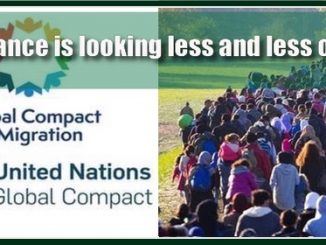
Crisis brewing in ‘parking lot for migrants’
Some 120,000 migrants are currently heading towards Croatia, en route to enter the European Union via the popular Western Balkan route. Croatian police have been put on alert.
FREEWEST MEDIA
Croatian capital Zagreb is preparing for a fresh flood of migrants.
Thousands of “asylum seekers” have been stranded in neighbouring non-EU states Serbia and Bosnia Herzegovina, which are both struggling to deal with the numbers.
A Serbian outlet, Jutarnji List reported that this latest wave of migrants was created after the former Balkan route through Macedonia was closed.
 Serbian MP Sanda Ivic warned last month that the EU was seeking to turn the Balkan Peninsula into a “parking lot for migrants,” bullying weak nations.
Serbian MP Sanda Ivic warned last month that the EU was seeking to turn the Balkan Peninsula into a “parking lot for migrants,” bullying weak nations.
“The EU is no longer ready to accept large masses of migrants, so it needs some kind of filter to stem the flow of refugees; but it can’t use Turkey for this purpose because the latter could start blackmailing Brussels,” Ivic told Sputnik News.
“These countries are weaker so you can always threaten them or bribe them so that they do you a favor and accommodate all those people. The EU needs a parking lot for migrants.”
According to official statements made by representatives of the Slovenian police, the pressure on this route is extremely high, as there are currently between 50,000 and 60,000 migrants in the area between Greece and Albania, whose only purpose is to reach Western Europe.
There is already chaos in Sarajevo, which continues daily, with hundreds of migrants entering Bosnia Herzegovina every day from Syria, Libya, Afghanistan, Palestine, Pakistan, Algeria, Morocco, Iraq, Turkey, Iran, Tunisia and other countries.
“Croatia will do everything to protect its border and prevent any attempts at crossing the border illegally and has all the necessary resources for that. We are prepared to assist Bosnia and Herzegovina in that regard,” Croatian President Kolina Grabar-Kitarović told news agency HINA.
She said that Croatia could deploy police officers through the EU border control agency Frontex to control the border at the Mali Zvornik crossing between Bosnia and Serbia.
Authorities in Zagreb say they are currently monitoring the increased influx of migrants on the new route across Bosnia and Herzegovina and their attempts to get to EU countries through Croatia.
“The experience of managing the migrant wave in 2015 points to the conclusion that only with coordinated action of all the relevant state services on the route can any response to this challenge be successful. We recently spoke about this at the Brdo-Brijuni Process Summit in Skopje, considering the significance of this issue for the stability of the entire Southeast Europe,” the president said.
Security Minister Dragan Mektić and the chief of police of the Bosniak-Croat Federation entity Dragan Lukač have both warned that the decision to prevent columns of buses full of migrants travelling from Sarajevo to Mostar, which was most likely adopted by the police in Herzegovina-Neretva canton, was unprecedented and represented a threat to the constitutional-legal order of the country.
 The migrant crisis in Bosnia and Herzegovina is turning into a political powderkeg with unforeseeable consequences as various levels of government (pictured) are arguing about how to respond to the increased influx of refugees and who is responsible for their care.
The migrant crisis in Bosnia and Herzegovina is turning into a political powderkeg with unforeseeable consequences as various levels of government (pictured) are arguing about how to respond to the increased influx of refugees and who is responsible for their care.
One of the most vulnerable points of entry into the EU, is Croatia. Migrants then travel north through Slovenia and on to more lucrative destinations, such as Germany. Croatia is EU border territory, located next to Bosnia and Herzegovina, Serbia and Montenegro.
“If they find a weak point, we will face hundreds of migrants in their attempt to break through the border,” a police source told Croatian media.
“According to official statements made by representatives of Slovenian police, the pressure on this route is extremely high, while there are currently between 50,000 and 60,000 migrants in the area between Greece and Albania, whose sole goal is to reach Western Europe,” reported Serbian outlet B92, but they also reported that the number of incoming illegal immigrants was much higher.
“The situation in [Bosnia and Herzegovina] is being monitored as well, from where warnings are coming of up to 120,000 migrants approaching the country.”
CONTINUE READING HERE
ER recommends other articles by FreeWest Media
Photo credit: Chairman of Council of Ministers of Bosnia and Herzegovina (BiH) Denis Zvizdic (C) speaks at a press conference in Sarajevo, Bosnia and Herzegovina, on May 14, 2018. [Photo/Xinhua]




